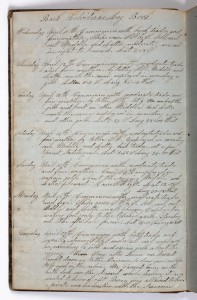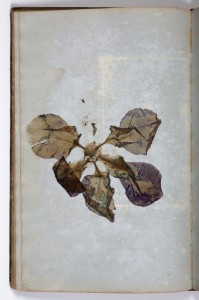In 1849, the Cayuga Joint Stock Company of Auburn, NY set sail for California. The company of men had their sights set on California’s gold, and established their joint stock company “to engage in mining, trading and such other business in the territory of California” according to the company by-laws. For a nominal fee of $500, anyone (of good reputation, of course) could become a member and receive his fair share.
In 1883, W.A. Ogden presented a paper to the Cayuga County Historical Society. Ogden was a member of the Cayuga Joint Stock Company and a passenger on the barque Belvidere during its passage from New York to San Francisco. In his paper he recalls their journey and their successes upon landing in California. (Read other Past is Present posts about California.)
 In 2011, here at AAS, we have a fabulous collection of log books, which shed light on over 150 years of American maritime history. Included in this collection is the log book of the barque Belvidere, the Baltimore Clipper carrying the entirety of the Cayuga Joint Stock Company to California. And we come full circle!
In 2011, here at AAS, we have a fabulous collection of log books, which shed light on over 150 years of American maritime history. Included in this collection is the log book of the barque Belvidere, the Baltimore Clipper carrying the entirety of the Cayuga Joint Stock Company to California. And we come full circle!
Comparing Ogden’s reminiscences of the voyage with the log book completes the experience of working with this primary resource. Log books are excellent for researching maritime history, but on their own it’s difficult to reconstruct a complete voyage. Pair the log book with a diary or reminiscences such as Ogden, and you’ll get a much more complete picture.
For example, reading the log book will tell us the Belvidere dropped anchor in Peru, but thanks to Ogden’s writings, we also know the crew visited the Peruvian Library (which had over 20,000 volumes!) and that Ogden thought Peruvian women to be quite attractive. Also, on April 16th, the log book can tell us the wind, the weather, and the course of the clipper. But because of Ogden, we also know that on this day, although the ocean seemed calm, the passengers were not:
The 16th of April we had what might be termed a family row on a large scale; Captain Barney, who was very sensitive and quick to take offence, had heard some criticism by member of the company in regard to his management. He called the company “aft” on the quarter deck, and gave us a speech, threatening that unless apologies were made and he was sustained by the company, he would take the ship into Rio Janeiro and deliver her over to consul.
 And what the log book can do for historical research that reminiscences cannot is provide us with an amazing tactile connection to history. While our collections are important for the information they hold, this log book also has that awe factor of its physicality. After learning about the voyage, and the history behind the men aboard, the book serves as a relic of the voyage, and connects us to the experience. Perhaps Ogden recalled collecting flowers from Peru; however we can see the actual pressed flowers in the log book. The log book serves as a common element between us and the men of the Cayuga Joint Stock Company from over 150 years ago, and provides an amazing historical experience!
And what the log book can do for historical research that reminiscences cannot is provide us with an amazing tactile connection to history. While our collections are important for the information they hold, this log book also has that awe factor of its physicality. After learning about the voyage, and the history behind the men aboard, the book serves as a relic of the voyage, and connects us to the experience. Perhaps Ogden recalled collecting flowers from Peru; however we can see the actual pressed flowers in the log book. The log book serves as a common element between us and the men of the Cayuga Joint Stock Company from over 150 years ago, and provides an amazing historical experience!

our great great grandfather was on the Belvidere as a member of the Cayuga Joint Stock Company – is it possible to view this document to see if he is mentioned ?
Karen,
Thanks for your comment – that’s very exciting! I’m not sure where you are located, but if you are close to Worcester, AAS is free and open to the public. Please see our website at http://www.americanantiquarian.org/libraryuse.htm for information about using the library. If a trip is not possible, you can find information about reproduction options at http://www.americanantiquarian.org/reproductions.htm.